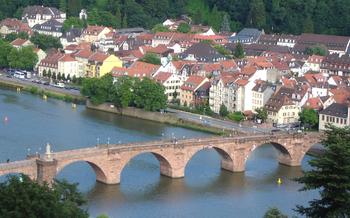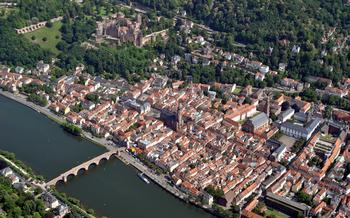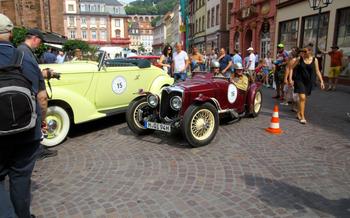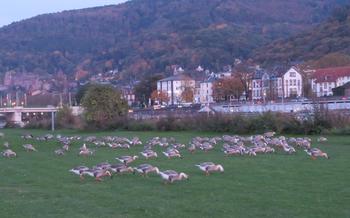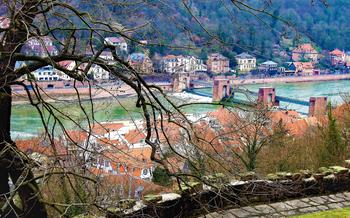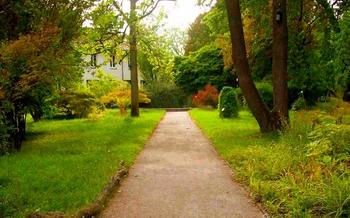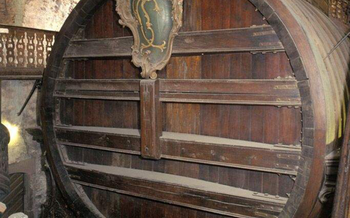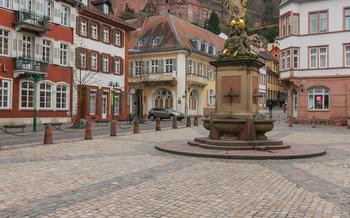
Bergbahn Heidelberg (Funicular Railway)
- History of the Bergbahn Heidelberg
- Scenic Views from the Funicular
- Practical Information for Visitors
- Getting to the Bergbahn Heidelberg
- Heidelberg Card Benefits
- Accessibility for People with Disabilities
- Tips for a Memorable Funicular Ride
- Historical Significance of the Bergbahn
- The Philosophers' Walk and Bergbahn
- The Bergbahn and Heidelberg's Cable Cars
- Local Legends and Folklore
History of the Bergbahn Heidelberg
The Bergbahn Heidelberg, also known as the Heidelberg Funicular Railway, is a remarkable engineering marvel that has played a significant role in the city's history and development. Its construction began in 1890, driven by the need to connect the Old Town with the hillside district of Neuenheim and the iconic Heidelberg Castle. The funicular was inaugurated in 1891, becoming a pioneering transportation system in Germany and a symbol of Heidelberg's innovative spirit.
During World War II, the Bergbahn played a crucial role in transporting people and goods to and from the castle, which served as a military hospital. Despite the challenges of the war, the funicular continued to operate, providing essential services to the community. In the aftermath of the war, the Bergbahn underwent extensive reconstruction and modernization, ensuring its continued operation for generations to come.
Scenic Views from the Funicular
The Bergbahn Heidelberg offers breathtaking panoramic vistas of the city and its surroundings. As the funicular ascends the Königstuhl hill, passengers are treated to ever-changing views of Heidelberg's iconic landmarks. The Neckar River, meandering through the valley below, glistens in the sunlight, while the Old Town, with its red-tiled roofs and historic buildings, unfolds like a storybook scene.
The Heidelberg Castle, perched majestically on a hilltop, dominates the skyline. Its imposing towers and ramparts recall centuries of history and intrigue. From the funicular, you can admire the castle's grand architecture and imagine the lives of the electors and princesses who once resided within its walls.
Another highlight of the journey is the Philosophers' Walk, a picturesque footpath that winds along the Neckar River. Named after the renowned philosophers who frequented this path, it offers stunning views of the river, the Old Town, and the surrounding hills. The funicular provides a unique perspective of this idyllic setting, allowing you to appreciate its natural beauty and historical significance.
As the funicular reaches the Königstuhl hilltop, the panorama expands to include the vast forests of the Odenwald and the distant peaks of the Black Forest. From the observation tower at the summit, you can enjoy a breathtaking 360-degree view that encompasses the entire Rhine-Neckar region. This unforgettable experience is sure to leave a lasting impression on every visitor.
Practical Information for Visitors
The Bergbahn Heidelberg is conveniently located in the heart of Heidelberg, making it easily accessible by foot, public transportation, or private vehicle. The funicular railway station is situated on Kornmarkt Street, adjacent to the Old Town and Heidelberg Castle. Visitors can purchase tickets at the station's ticket office or online through the Bergbahn Heidelberg website.
Ticket prices vary depending on the type of ticket and the age of the passenger. A single ticket for a one-way trip costs €50 for adults and €50 for children aged 6-A round-trip ticket costs €50 for adults and €50 for children. Discounts are available for families, groups, and holders of the Heidelberg Card.
The Bergbahn Heidelberg operates daily, with the first departure from Kornmarkt at 9:00 AM and the last departure from Königstuhl at 6:00 PM. During peak tourist season, the funicular runs more frequently, with departures every 10-15 minutes. The journey from Kornmarkt to Königstuhl takes approximately 8 minutes, offering visitors ample time to enjoy the breathtaking views of Heidelberg and the surrounding countryside.
Getting to the Bergbahn Heidelberg
Reaching the Bergbahn Heidelberg is a breeze, offering visitors several convenient transportation options. For those utilizing public transportation, the city's efficient tram network provides direct access to the funicular. Tram lines 21 and 23 stop right at the Kornmarkt station, a short walk from the Bergbahn's lower station.
For those arriving by car, limited parking spaces are available near the lower station, subject to availability. However, it's advisable to consider alternative parking options or utilize public transportation to avoid the hassle of finding a parking spot.
If you're up for a pleasant stroll, the Bergbahn Heidelberg is within easy walking distance from Heidelberg's Old Town and other popular landmarks. The picturesque route takes you through charming streets, past historical buildings, and offers glimpses of the Neckar River. For those seeking a more direct path, the funicular is also accessible via a scenic footpath leading from the Old Town to the lower station.
Heidelberg Card Benefits
In addition to offering a convenient and enjoyable way to explore Heidelberg, the Heidelberg Card provides visitors with a range of enticing benefits, including free or discounted rides on the Bergbahn Heidelberg. This card is a true value-for-money option, allowing travelers to save money while maximizing their sightseeing experiences.
With the Heidelberg Card, you can enjoy unlimited rides on the Bergbahn, as well as free or discounted admission to many other attractions and tours in the city. This includes popular destinations such as Heidelberg Castle, the German Pharmacy Museum, and the Kurpfälzisches Museum. The card also offers discounts on guided tours, bike rentals, and even boat trips on the Neckar River.
The Heidelberg Card is available for purchase for one, two, or three days, providing flexibility for visitors with different itineraries. It can be purchased online or at various points of sale in Heidelberg, including the tourist information center.
To make the most of your Heidelberg Card, plan your itinerary carefully and identify the attractions and tours you want to visit. By combining the convenience of the Bergbahn with the savings offered by the Heidelberg Card, you can create a memorable and cost-effective travel experience in this beautiful city.
Accessibility for People with Disabilities
The Bergbahn Heidelberg is committed to ensuring accessibility for visitors with disabilities. Both the Kornmarkt and Molkenkur stations are wheelchair accessible, with ramps and elevators providing easy access to the platforms. Passengers requiring assistance with boarding and disembarking the funicular cars can request assistance from the friendly staff, who are always ready to lend a helping hand. Designated spaces on the funicular cars are reserved for wheelchair users, ensuring a comfortable and safe journey for all.
For those unable to use the funicular due to mobility limitations, alternative options are available. Visitors can enjoy the stunning views of Heidelberg from the accessible viewing platform at the Kornmarkt station. Additionally, the city offers a range of accessible transportation options, including low-floor buses and taxis, making it easy to explore Heidelberg's attractions.
Tips for a Memorable Funicular Ride
To make the most of your Bergbahn Heidelberg experience, consider the following tips:
-
Choose the best time of day for views: The best time to ride the funicular for stunning views is either early in the morning or late in the evening. At these times, the light is often softer and more golden, creating a beautiful ambiance.
-
Avoid crowds and peak tourist hours: If possible, try to avoid riding the funicular during peak tourist hours, which are typically between 11 am and 3 pm. This will help you avoid long lines and crowds, and you'll be able to enjoy the views more peacefully.
-
Combine the ride with other Heidelberg attractions: The Bergbahn is conveniently located near many of Heidelberg's top attractions, such as Heidelberg Castle, the Philosophers' Walk, and the Königstuhl hilltop. Combine your funicular ride with a visit to one or more of these attractions to make the most of your time in Heidelberg.
-
Capture stunning photographs: The Bergbahn offers many opportunities for capturing stunning photographs. Be sure to bring your camera and take advantage of the panoramic views from the funicular cars. You can capture beautiful shots of the Neckar River, the Old Town, Heidelberg Castle, and the surrounding countryside.
Historical Significance of the Bergbahn
The Bergbahn Heidelberg has played a significant role in the development of Heidelberg's tourism industry. Since its inception, it has attracted visitors from around the world to experience the city's stunning scenery and historical landmarks. The funicular has also contributed to Heidelberg's infrastructure by providing a convenient and efficient means of transportation between the Old Town and the Königstuhl hilltop.
This engineering marvel stands as a symbol of Heidelberg's cultural heritage and is recognized as a historical landmark. Its unique design and remarkable history have made it a beloved attraction among locals and tourists alike. The Bergbahn's enduring legacy is a testament to its importance in shaping Heidelberg's identity as a vibrant and welcoming city.
The Philosophers' Walk and Bergbahn
Just a short walk from the Bergbahn's upper station, you'll find the renowned Philosophers' Walk, a picturesque path that winds along the hillside, offering breathtaking views of the Neckar Valley and the Old Town. Named after the many philosophers and intellectuals who frequented it in the 19th century, this idyllic promenade invites you to stroll, contemplate, and soak in the natural beauty that surrounds you.
As you wander along the Philosophers' Walk, you'll encounter various sculptures and plaques dedicated to famous thinkers and writers, such as Friedrich Nietzsche, who found inspiration in this serene setting. The walk's combination of nature, history, and philosophy creates a unique atmosphere that has captivated visitors for generations.
Whether you're a history buff, a nature enthusiast, or simply seeking a tranquil escape, the Philosophers' Walk, in conjunction with the Bergbahn, offers an unforgettable experience that immerses you in Heidelberg's rich cultural heritage and stunning natural landscapes.
The Bergbahn and Heidelberg's Cable Cars
The Bergbahn Heidelberg is part of a larger network of cable cars and funiculars that traverse the city's hills and valleys. This interconnected system provides a comprehensive transportation and sightseeing experience for visitors.
The two most notable cable cars in Heidelberg are the Heidelberger Bergbahn and the Molkenkurbahn. While the Bergbahn offers stunning views of the Old Town and Neckar River, the Molkenkurbahn takes visitors to the top of the Heiligenberg hill, providing panoramic vistas of the surrounding countryside.
The Heidelberger Schlossbahn is another funicular railway that connects the Old Town with Heidelberg Castle. This historic railway offers a unique perspective of the castle and its surroundings, making it a popular attraction for tourists and locals alike.
By combining rides on the Bergbahn, Molkenkurbahn, and Schlossbahn, visitors can create a comprehensive Heidelberg cable car experience. This allows them to explore different parts of the city, enjoy breathtaking views, and gain a deeper understanding of Heidelberg's rich history and culture.
Interconnections between the different cable car systems are seamless, with transfer options available at various points. This makes it easy for visitors to create personalized itineraries and explore Heidelberg at their own pace.
Local Legends and Folklore
The Bergbahn Heidelberg is deeply intertwined with the local legends and folklore of the city. One popular tale tells of a mischievous gnome named Rumpel, who is said to have helped construct the funicular railway. According to legend, Rumpel used his magical powers to transport rocks and materials up the steep slopes, ensuring the timely completion of the project.
Another legend associated with the Bergbahn is that of the "White Lady," a ghostly figure who is said to appear on the funicular at night. Legend has it that the White Lady is the spirit of a young woman who lost her life during the construction of the railway. Her apparition is believed to bring good luck to those who catch a glimpse of her.
The Bergbahn is also a symbol of hope and resilience for the people of Heidelberg. During World War II, the funicular played a crucial role in transporting food and supplies to the residents who sought refuge in the hills surrounding the city. The Bergbahn's continued operation during such difficult times is a testament to the enduring spirit of Heidelberg and its people.
